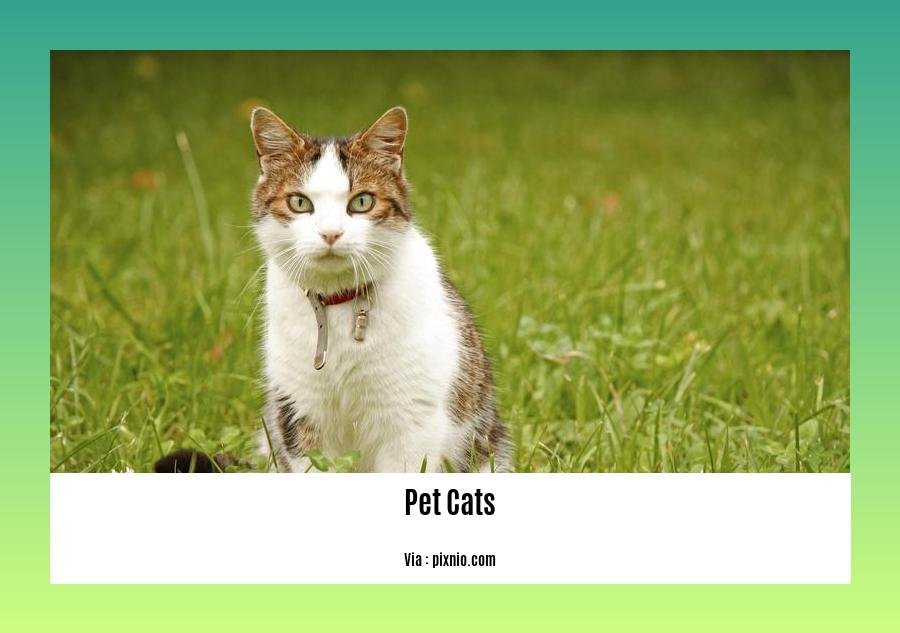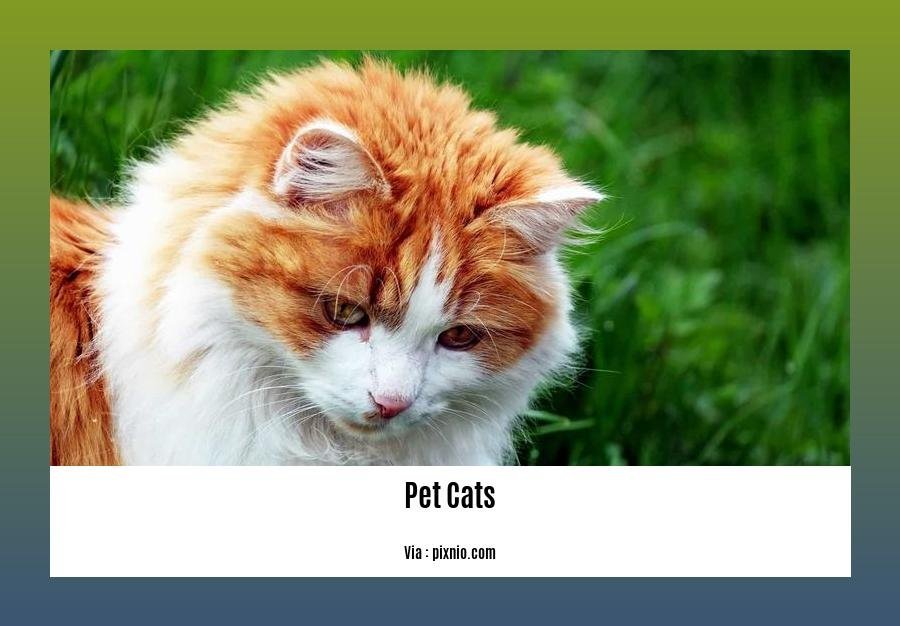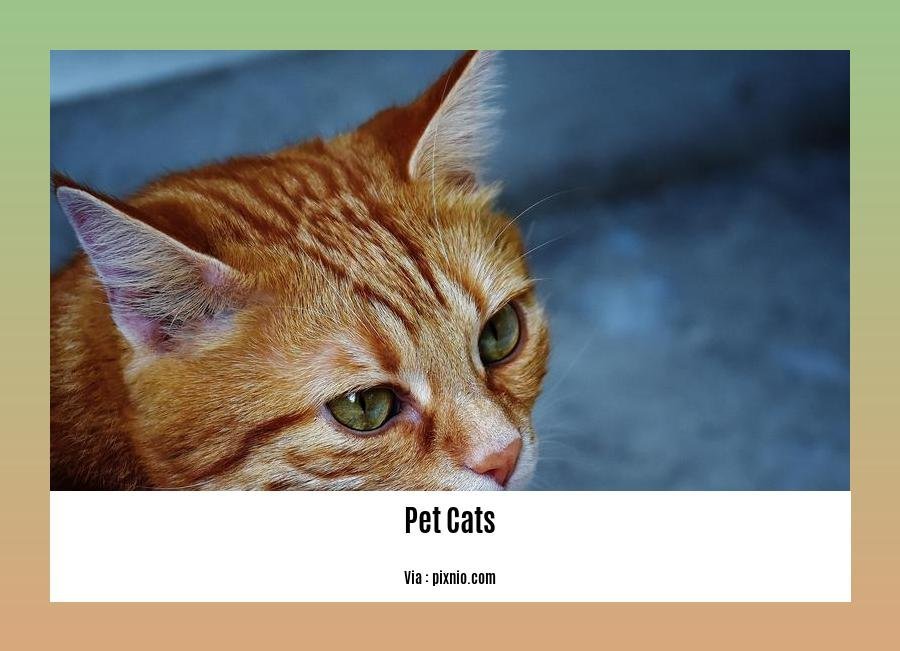Discover the enigmatic world of feline companions with our fascinating facts about pet cats. As seasoned pet enthusiasts with years of experience in veterinary medicine and a deep understanding of their unique behaviors and needs, we are here to provide you with accurate and insightful information. From the various cat breeds to their health issues, dietary requirements, and grooming techniques, we aim to help you deepen your bond with your furry friends and provide them with a fulfilling life.
Key Takeaways:
- Cats are one of the most popular pets worldwide, with over 500 million domestic cats.
- Cats and humans have been living together for nearly 10,000 years.
- Cats sleep an average of 13 to 14 hours a day.
- Cats have flexible bodies and teeth adapted for hunting small animals.
- Cats have over 30 muscles controlling their ears, allowing them to rotate their ears 180 degrees.
- Cats are the most popular pet in the USA, with 88 million cats kept as pets.
- Cats sleep 70% of their lives and can sleep in various positions.
- Cats walk in a pacing gait, where the legs on one side of the body move in unison, followed by the legs on the other side.
- Cats have a playful and affectionate personality, making them popular companions for many people.
Facts About Pet Cats: Uncover the Enigmatic World of Feline Companions

Cats are fascinating creatures with a long history of association with humans. Whether you’re a seasoned cat owner or just starting to explore the world of feline companionship, there are plenty of interesting facts that can deepen your understanding and appreciation for these enigmatic creatures. Here, we uncover some intriguing facts about pet cats that will leave you amazed.
Cats and Humans: A Historical Bond
Did you know that cats and humans have been living together for nearly 10,000 years? It’s true! Cats were first domesticated in the Near East and eventually spread to different parts of the world. Today, cats are one of the most popular pets globally, with over 500 million domestic cats as our beloved companions.
Sleeping Beauties: Cats and Their Snooze Fest
You might have noticed that cats seem to spend an awful lot of time sleeping. In fact, they sleep for an average of 13 to 14 hours a day! But why do they need so much shut-eye? It turns out that cats have evolved as energy-conservationists. Their hunting instincts require short bursts of intense energy, followed by long periods of rest to recharge. So, the next time you catch your furry friend napping, remember that they’re just recharging their batteries for their next adventure!
Cat as Ultimate Predators: A Lesson in Adaptation
Cats possess incredible physical traits that make them highly efficient predators. Their flexible bodies and sharp teeth are perfectly adapted for hunting small animals like mice and rats. But did you know that cats also have an astonishing control over their ears? With over 30 muscles that rotate their ears 180 degrees, cats have an unparalleled ability to perceive sounds and detect prey. It’s no wonder they’re such skilled hunters!
America’s Feline Obsession: Cats are the Top Pets
In the United States alone, cats reign supreme as the most popular pet. With a whopping 88 million cats kept as pets, they’ve stolen the hearts of millions of Americans. Known for their playful and affectionate nature, cats have become cherished companions for many households. So, if you’re looking for a furry friend to keep you entertained and showered with love, a cat might just be the purrfect choice!
A Cat’s Walking Style: An Elegant Pacing Gait
Have you ever noticed how gracefully cats move? Well, their walking style is quite unique. Unlike dogs or humans, cats use a pacing gait, where the front and back legs on one side of their body move in unison, followed by the legs on the other side. This elegant striding motion allows them to maintain better balance and maximize their agility. It’s like watching a dance of grace every time they take a step!
The Many Faces of Cat Sleep: A Lifestyle Choice
Cats are known for their love of slumber, and they sure do it in style! Sleeping up to 70% of their lives, cats can catch their Z’s in various positions. Whether they’re curled up into a cozy ball, stretched out like a supermodel, or taking a catnap with one eye open, they’re masters of relaxation. And let’s be honest, who wouldn’t love to have the ability to sleep anywhere, anytime?
With their intriguing history, unique physical abilities, and lovable personalities, cats continue to capture our hearts and enrich our lives. So, the next time you cuddle up with your feline friend, remember these fascinating facts that make them truly remarkable companions.
If you’re curious about fascinating facts about ocean life, click here to discover the wonders that lie beneath the waves.
Explore the unique bond between pets and humans by uncovering incredible facts about pets and humans. Click on the link to delve into the heartwarming stories of companionship and love.
The world of police dogs is truly awe-inspiring. Learn remarkable facts about police dogs and be amazed by their intelligence, strength, and dedication. Click here to uncover their heroic tales.
Common Health Issues in Cats: Uncover the Enigmatic World of Feline Companions

As a cat owner, it’s important to understand the common health issues that can affect our feline friends. Cats, like any other creatures, are susceptible to certain ailments and conditions. By having this knowledge, we can take proactive steps to ensure their well-being and provide timely care when needed.
Dental Problems: The Hidden Dangers in Their Mouths
One of the common health issues in cats revolves around their oral health. Just like humans, cats can suffer from dental problems. Plaque, tartar, gingivitis, and tooth decay are all potential issues that can arise. These oral conditions can be painful for our feline companions and, if left untreated, may lead to more serious health complications.
Trauma and Injury: Navigating the Road to Recovery
Another common health concern in cats is trauma or injury. Unfortunately, accidents can happen, and cats are not immune to the risks. Wounds, fractures, sprains, and burns are examples of injuries that cats may face. It’s crucial to keep a vigilant eye on our cats, especially if they have access to the outdoors, to spot any signs of trauma or injury and provide them with proper care and treatment.
Skin Problems: Beyond Fluffy Fur
Cats are known for their beautiful fur, but sometimes, skin problems can arise. Flea infestations, allergies, infections, and hair loss are among the common issues seen in our feline companions. These problems can cause discomfort and affect their overall well-being. By addressing and treating skin issues promptly, we can help our cats feel more comfortable in their own skin.
Digestive Distress: Handling Tummy Troubles
Digestive problems can also affect cats, causing distress for both the cat and their owner. Vomiting, diarrhea, worms, and food intolerance are common issues that may arise. Paying attention to their eating habits, stool consistency, and overall behavior can help identify any digestive issues. Seeking veterinary advice and making necessary dietary adjustments can go a long way in alleviating these problems.
Urinary Tract Problems: Uncovering the Source of Unease
Urinary tract problems are prevalent in cats and can cause significant discomfort. Infections, stones, blockages, and inflammation can all affect their urinary system. These issues may manifest as increased frequency of urination, blood in the urine, or urinating outside the litter box. Prompt veterinary care and appropriate treatment are crucial in managing urinary tract problems and ensuring a healthier, happier cat.
Eye Problems: Protecting Their Vision
The delicate nature of a cat’s eyes makes them prone to certain ailments. Conjunctivitis, cataracts, glaucoma, and ulcers are common eye problems in cats. Monitoring for symptoms like redness, discharge, cloudiness, or changes in behavior can help identify potential issues. Early intervention and proper eye care can help safeguard their vision and prevent further complications.
Respiratory Troubles: A Breath of Concern
Cats can also experience respiratory problems. Conditions such as cat flu, asthma, bronchitis, and pneumonia can impact their ability to breathe comfortably. Recognizing symptoms like coughing, sneezing, wheezing, or labored breathing is crucial. Seeking veterinary assistance and following the prescribed treatment plan can help mitigate respiratory issues and improve their quality of life.
Obesity: The Weighty Consequences
Obesity is a growing health concern in cats and can lead to various other health problems. Diabetes, arthritis, heart disease, and liver problems are some of the potential consequences of excess weight. Maintaining a healthy weight through balanced nutrition and regular exercise is vital for preventing obesity-related complications in our feline friends.
Key Takeaways:
– Dental problems, skin problems, and urinary tract problems are common health issues in cats that require attention and treatment.
– Trauma or injury can affect cats, and prompt care is necessary to aid their recovery.
– Eye problems, respiratory troubles, and digestive distress are other health concerns that can impact a cat’s well-being.
– Obesity is a significant issue that can lead to various health complications in cats.
– Vigilance, regular veterinary check-ups, and providing a nutritious diet are essential in safeguarding our feline companions’ health.
Sources:
1. RSPCA: Cat Health Issues
2. WebMD: 6 Most Common Cat Health Problems
Proper Nutrition and Dietary Requirements for Cats
Proper nutrition is crucial for ensuring the health and well-being of our beloved feline companions. Cats have unique dietary requirements that need to be met in order for them to thrive. In this article, we will explore the key aspects of cat nutrition and provide you with valuable insights to help you make informed decisions about your cat’s diet.
Understanding Cat Nutritional Needs
Protein is an essential nutrient for cats, as it aids in the building of body tissues and plays a vital role in disease prevention. Amino acids, the building blocks of proteins, are also necessary for cats to meet their nutritional needs [^1^]. In addition to protein, cats require other nutrients such as vitamins, minerals, fatty acids, and amino acids to maintain their overall health. It’s important to strike a balance with these nutrients, as an excessive intake is not always beneficial for cats [^2^].
The dietary requirements of domesticated cats are similar to their wild counterparts, with the ideal diet consisting of approximately 55% protein, 45% fat, and 1 to 2% carbohydrates. Cats’ bodies are designed to metabolize protein and fat for energy, making these nutrients essential for their well-being [^2^].
The Role of Fat in a Cat’s Diet
Contrary to common misconceptions, a cat’s diet can include reasonably high levels of fat without adverse effects. Some cat foods contain 50% or more of their energy from fat, and studies have shown that even higher fat content is safe. However, it is recommended that cat foods have a minimum fat content of about 9% of dry matter [^3^]. High-quality ingredients such as meat and animal fat should be included in a cat’s diet, as they provide essential amino acids like taurine and arginine. On the other hand, grains and vegetable oil should be avoided in cat diets [^4^].
Ensuring Your Cat’s Longevity and Well-being
Understanding and meeting the nutritional requirements of your cat is crucial in ensuring their long and healthy lives. A balanced and high-quality diet contributes significantly to their overall well-being. By providing the right nutrients in proper proportions, you can help prevent various health issues and promote a thriving lifestyle for your feline friend [^5^].
Key Takeaways:
– Protein is essential for cats as it helps in building body tissues and plays a role in disease prevention.
– Cats require a balanced intake of amino acids to meet their nutritional needs.
– Fat is an important component of a cat’s diet, with reasonably high levels being safe and recommended.
– High-quality ingredients such as meat and animal fat provide essential amino acids like taurine and arginine.
– Grains and vegetable oil should be avoided in cat diets.
– Understanding and meeting the nutritional requirements of your cat contributes to their long and healthy lives.
Citations:
[^1^]: Cat Nutrition | UK Pet Food
[^2^]: The Complete Guide To Feline Nutrition – Cats.com
[^3^]: The National Academies Press: Cat Nutrition
[^4^]: The Complete Guide To Feline Nutrition – Cats.com
[^5^]: Feeding Your Cat | Cornell University College of Veterinary Medicine
Essential Grooming Tips for Pet Cats
Keeping your pet cat looking and feeling their best goes beyond just cuddles and playtime. Grooming plays a crucial role in their overall health and well-being. Whether you’re a new cat owner or have been living with feline companions for years, these essential grooming tips will help you maintain a clean and healthy coat for your beloved pet.
Start Early and Make It Positive
Grooming Tip #1: Start grooming your cat at an early age to get them used to being touched. This will help them feel more comfortable during grooming sessions as they grow.
Grooming Tip #2: Schedule grooming sessions when your cat is relaxed, such as after a nap. This will make the experience more enjoyable for both of you.
Grooming Tip #3: Make grooming sessions fun by using treats and playing with toys to reward your cat for staying calm and cooperative.
Brushing Away Dirt and Tangles
Grooming Tip #4: Brush away dirt from your cat’s fur using a soft-bristled brush or comb. Regular brushing helps remove loose hairs and prevents matting.
Grooming Tip #5: When encountering tangles or mats, gently detangle them using your fingers or a mat comb. Be patient and avoid pulling on the fur, as it may cause discomfort.
Grooming Tip #6: If necessary, give your cat a haircut to keep their fur manageable and prevent matting. Consult a professional groomer or veterinarian for guidance on trimming techniques.
Maintain Skin and Coat Health
Grooming Tip #7: Treat dandruff by using a moisturizing shampoo specifically designed for cats, or consult with a veterinarian for product recommendations.
Grooming Tip #8: Clean up shed hairs regularly using a lint roller or vacuum cleaner. This helps prevent excessive hair accumulation around your home.
Grooming Tip #9: Groom your cat’s ears by gently wiping away any dirt or buildup using a soft, damp cloth. Be cautious not to insert any objects into their ear canal.
Grooming Tip #10: Pay attention to your cat’s skin and fur for any changes or abnormalities, such as redness, sores, or excessive itching. If you notice anything concerning, consult with a veterinarian.
Nail Trimming and Dental Care
Grooming Tip #11: Trim your cat’s claws regularly to prevent them from becoming too long and causing discomfort or injury. Use specialized cat nail clippers and be careful not to cut too close to the quick.
Grooming Tip #12: Take care of your cat’s dental health by brushing their teeth regularly with a toothbrush and toothpaste made specifically for cats. This helps prevent dental issues and keeps their breath fresh.
The Importance of Overall Health
Grooming Tip #13: Provide your cat with a healthy diet that promotes a glossy coat and overall well-being. Consult with a veterinarian to ensure you’re feeding them a balanced and nutritionally rich diet.
Grooming Tip #14: Monitor your cat’s paws and nails, making sure to trim their nails when needed and check for any signs of injury or infection.
With these essential grooming tips, you can ensure your pet cat stays clean, healthy, and happy. Remember to approach grooming sessions with patience, reward good behavior, and seek professional help when necessary.
Key Takeaways:
– Start grooming your cat at an early age to get them used to it.
– Schedule grooming sessions when your cat is relaxed to make it enjoyable.
– Brush away dirt and tangles using a soft-bristled brush or comb.
– Treat dandruff with a moisturizing shampoo, or consult a veterinarian.
– Clean up shed hairs regularly to prevent excessive hair accumulation.
– Clean your cat’s ears gently with a soft, damp cloth.
– Trim your cat’s claws regularly to prevent discomfort or injury.
– Brush your cat’s teeth to maintain dental health.
– Provide a balanced diet for a healthy coat and overall well-being.
– Monitor your cat’s paws, nails, and skin for any issues.
Sources:
1. Cat Grooming Tips – 15 Things You Should Know – CatLovesBest
2. Cat Grooming Tips | ASPCA
FAQ
Q1: How many domestic cats are there worldwide?
A1: According to the context, there are over 500 million domestic cats worldwide.
Q2: How long do cats sleep on average?
A2: As mentioned in the context, cats sleep for an average of 13 to 14 hours a day to conserve energy.
Q3: Do cats have flexible bodies and teeth for hunting?
A3: Yes, cats have flexible bodies and teeth adapted for hunting small animals like mice and rats, as stated in the context.
Q4: What is the most popular pet in the USA?
A4: According to the information provided, cats are the most popular pet in the USA, with 88 million cats kept as pets.
Q5: What are some common health issues for cats?
A5: Cats can experience dental problems, trauma or injury, skin problems, digestive problems, urinary tract problems, eye problems, respiratory problems, and obesity, as mentioned in the context.
- China II Review: Delicious Food & Speedy Service - April 17, 2025
- Understand Virginia’s Flag: History & Debate - April 17, 2025
- Explore Long Island’s Map: Unique Regions & Insights - April 17, 2025
















